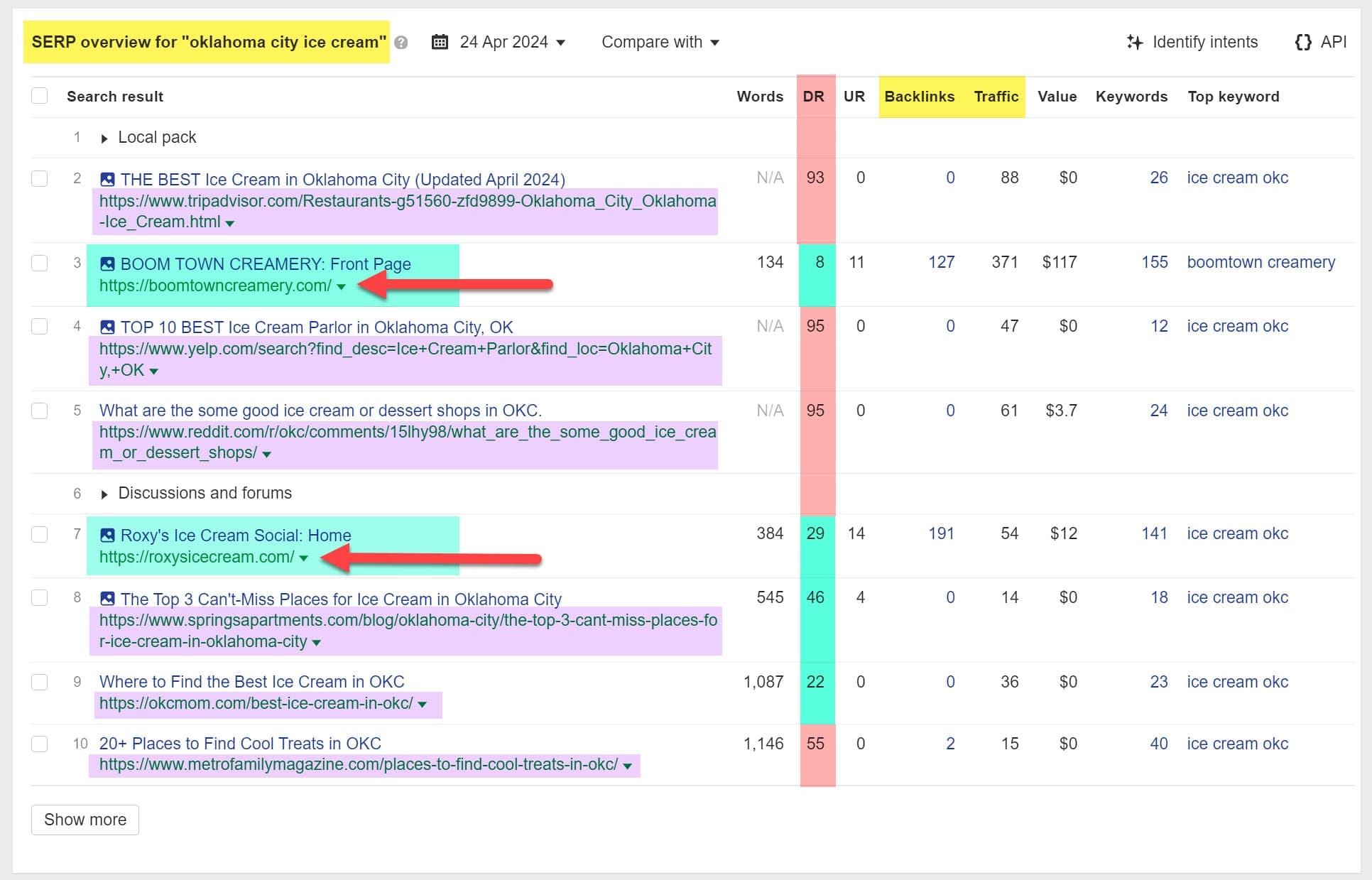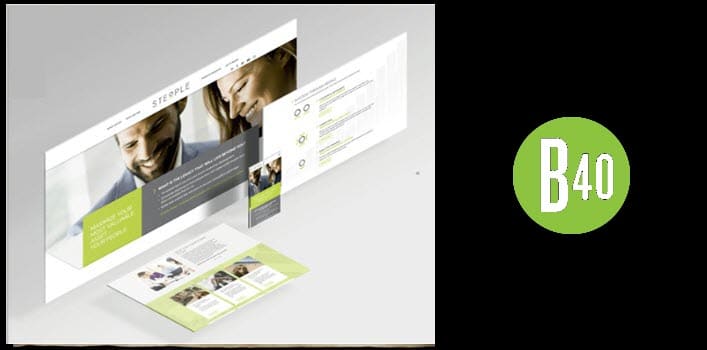
Look at the image above. Do you, as a business owner, notice anything important about this Google search for the keyword phrase ‘Oklahoma City Ice Cream?’ Most business owners would look at the image, even from a competitive intelligence research viewpoint, and despite the color-coded sections, would still not be sure what the significance is. In this article, we’ll uncover some aspects of SEO competitor research that you or your digital marketing agency may not have thought of.
What is SEO Competitive Analysis?
SEO Competitive Analysis is like a detective mission for your website. It’s all about studying your online rivals to understand what they’re doing well and how you can outshine them.
Imagine you’re a small business owner in a bustling marketplace. You want to stand out and attract customers, right? That’s where SEO Competitive Analysis comes in. It’s about examining what your competitors are doing with their online presence – their website, content, keywords, and more.
If your competitors are doing something right and ranking well in Google, then that could be an opportunity for us to apply a similar tactic to your website.
Why is SEO Competitive Analysis Important?
I thought I’d get one of the “DUH” questions and answers out of the way early!
SEO Competitive Analysis is crucial for small and medium-sized businesses (SMBs) because it provides valuable insights that can directly impact their online success. Here’s why it’s so important:
- Identifying Opportunities: By analyzing competitors’ strategies, SMBs (small business owners) can uncover untapped keywords, content gaps, and backlink opportunities that they may have overlooked. This insight helps them refine their own SEO strategy to attract more traffic and leads.
- Benchmarking Performance: Competitor analysis provides a benchmark against which SMBs can measure their own performance. By comparing key metrics such as: domain authority, page authority, monthly traffic volume, identifying what types of keywords are driving the organic traffic from Google (buyer terms vs. branded keywords), backlink profiles, and more help business owners gauge their progress and identify areas for improvement.
- Improving Content Strategy: By evaluating competitors’ content, SMBs can gain insights into what types of content resonate with their target audience. This knowledge enables them to create more engaging and valuable content that attracts and retains visitors.
- Gaining Competitive Advantage: Armed with a comprehensive understanding of their competitors’ strengths and weaknesses, SMBs can develop strategies to differentiate themselves and gain a competitive edge in the market
How to Conduct an SEO Competitor Analysis
When it comes to understanding how to outshine your competition online, conducting an SEO Competitor Analysis is key. By delving into what your rivals are doing, you can uncover valuable insights to strengthen your own digital presence. From identifying your SEO competitors to evaluating their keywords and content, each step plays a crucial role in shaping your strategy. Let’s break down these steps to see how you can gain a competitive edge in the digital arena.
Identify Your SEO Competitors
The first step in conducting an SEO competitor analysis is to identify who your competitors are. Most business owners assume they already know who they are, but it’s not as clear-cut as it may seem. If a client asks Back40 to perform an SEO competitor analysis, also referred to as an SEO Insights Report or SEO Strategy Development Report we ask our clients to list out at least three of their competitors. What we often find is that these competitor websites drive far less traffic than our clients thought. That alone can be enlightening, and then we have to figure out who their real competitors are within Google’s search results.
Start by searching for the keywords and phrases that are relevant to your business. Take note of the websites that appear on the first page of the search results. These websites are your direct competitors in the online space. However, without high end software to identify the best keywords you may only be finding competitors that rank well for second or third tier keywords (lower volume terms).
Investigate Your Competitors Top Pages
Now, let’s take a closer look at how to investigate your competitors’ top-performing pages. Start by identifying their most visited and highest-ranking pages. Tools like SEMrush or Ahrefs can help you uncover this information.
Once you have a list of these pages, analyze their content, structure, and keywords. Look for patterns or common themes that contribute to their success. Pay attention to factors such as page titles, headings, page tags, and page elements.
By understanding what makes these pages stand out, you can gain valuable insights into your competitors’ SEO strategies and identify opportunities to improve your own content and rankings.
Evaluate the Search Results for User Intent
User intent? What does that even mean?
User Intent refers to the goal or intention behind a user’s online search query. It’s about understanding what users are looking for when they type a particular keyword into a search engine. For example, someone searching for “best restaurants in New York” may have the intent of finding recommendations for dining options, while another person searching for “how to cook pasta” may be seeking cooking instructions or recipes.
User intent involves analyzing the types of content that appear in the search results for your target keywords and determining what users are looking for. Are they seeking information, products, services, or something else entirely?
By examining the search results and considering the context behind each query, you can tailor your content to better meet the needs and expectations of your target audience.
Analyze Competitors’ Keywords
What we observed was a keyword phrase (Oklahoma City Ice Cream), with only TWO of the top 10 results being local ice cream shops. If your business is an ice cream parlor, this is definitely not the major keyword to use because Google has decided to prioritize directories and other types of pages and sites. That’s not to say the keyword isn’t valuable, but it demonstrates why keyword analysis is so crucial. If you don’t choose the correct phrases for your company’s core pages, you may be missing out on a lot of BUYER traffic.
Other SEO Keyword Insights to Consider
- Keyword Competitiveness: Assess the competitiveness of the keywords your competitors are targeting. Can your site realistically rank for these keywords, given its authority and resources?
- Search Intent: Consider the intent behind the keywords—are they buyer terms indicating high purchase intent, or are they informational keywords used by customers at the top of the funnel? Understanding search intent helps you align your content with what your audience is looking for.
Analyze Your Competitors’ Content
Content is a crucial element of SEO. Analyzing your competitors’ content can give you valuable insights into what works in your industry. Take note of the topics they cover, the format of their content, and the engagement they receive.
But all content is not the same.
Writing content for a service web page, a product page, and a blog post are vastly different.
Distinguish between content meant to promote products or services and content designed to be a resource or informational asset. Service and product pages typically aim to convert visitors into customers, while blog posts or resource pages offer valuable insights to attract and engage audiences. Understanding this distinction helps you tailor your own content to align with your business goals and target audience needs.
Your competitor may be getting a lot organic traffic from Google, but in the end, it is buyer traffic that pays the bills. In short don’t get to hung up on total traffic volume.
GET IN TOUCH WITH THE BACK40 DESIGN OWNER TODAY!
Local SEO Competitive Analysis
If you run a business with a storefront or a service area company that travels to customers’ homes (for example, lawn care or landscaping), Local SEO Competitive Analysis is critical for dominating their local market.
Understanding how your competitors rank in local search results can provide useful insights into how to boost your own exposure in Google Maps and attract more clients.
Analyzing Local Competitors’ Google My Business Profiles
Your competitors’ Google Business Profile listing (GBP), previously known as a Google My Business (GMB) profile, is frequently the first point of contact for potential customers looking for local businesses similar to yours.
Analyzing their GBP profiles reveals how companies position themselves in local search results (Google Maps). This involves looking at their business information, images, reviews, and posts. By learning what your competitors do effectively, you can improve your own GMB profile to stand out and attract more clients.
Local SEO Competitive Analysis will help you improve your GMB presence, increase foot traffic or internet inquiries, and eventually boost your bottom line.
Assessing Local Citation and NAP Consistency
Local citations and NAP (Name, Address, Phone number) consistency across various online directories and platforms are crucial for local SEO success.
Inconsistent information can confuse search engines and potential customers, leading to lower rankings and missed opportunities. By assessing your own citation profiles, you can identify potential citation sources, discover inconsistencies, and ensure your business information is accurate and up to date.
Identify Opportunities and Develop Your Strategy
After thoroughly analyzing your competitors, it’s time to identify opportunities for improvement and develop your SEO strategy. Use the insights from a Back40 SEO competitive analysis report to gain insights into the competitive landscape and use it to redefine your digital marketing strategy to gain a competitive edge.
Back40 Design for Competitor SEO Research (Why Us?)

Back40 Design for Competitor SEO Research (Why Us?)
- We have decades of SEO research experience.
- We use professional tools.
- Most digital marketing agencies do basic SEO. At Back40 we actually specialize in competitive landscape analysis. You only get one chance to get it right. If you get it wrong, then it will show how your site performs in Google, no matter how awesome your site might look from a visual standpoint.
- You pay a good amount of money to build a quality site, but does it matter if no one ever sees it? At Back40 Design, we recommend that most businesses start with SEO research so that the website design and site navigation take the findings into account during the design phase.
In conclusion, conducting an SEO competitor analysis is vital for SMBs looking to improve their online visibility and outperform their rivals. By understanding your competitors’ strategies, keywords, and content, you can refine your own SEO approach and stay one step ahead in the digital arena. So, start analyzing your competitors today and unlock the potential for growth in your online presence.

Ready to overcome these challenges? Contact us for a free consultation to discuss how our SEO strategies can transform your online presence and help your business thrive. It all starts with a conversation!
